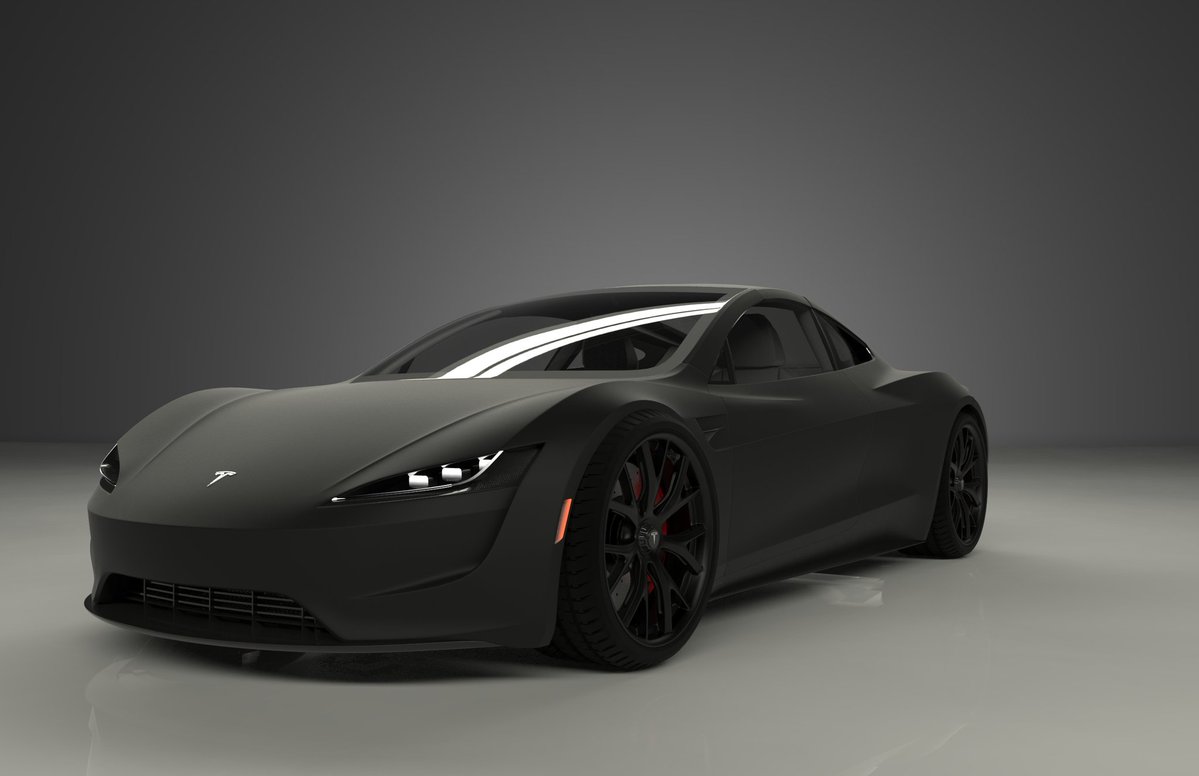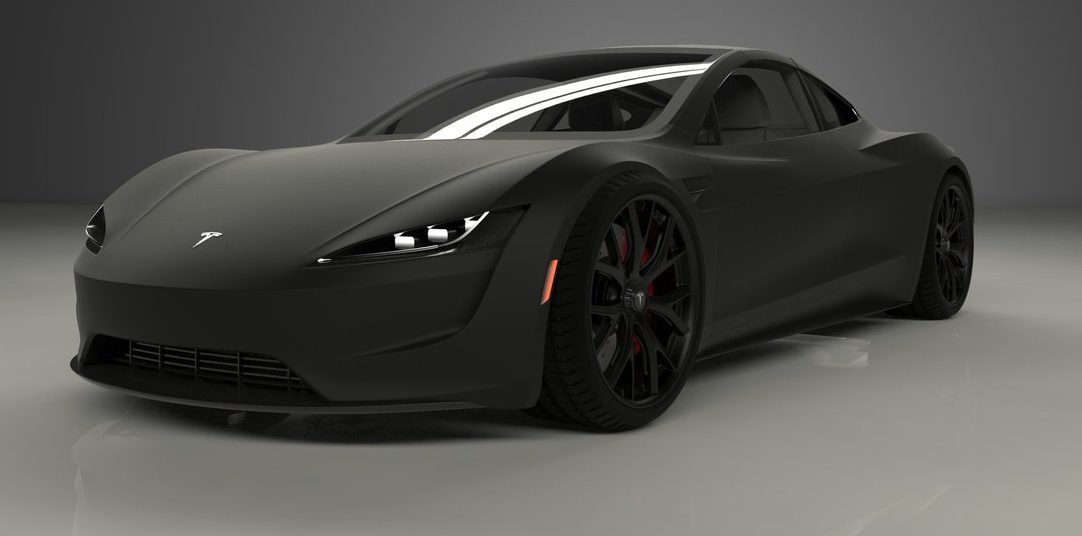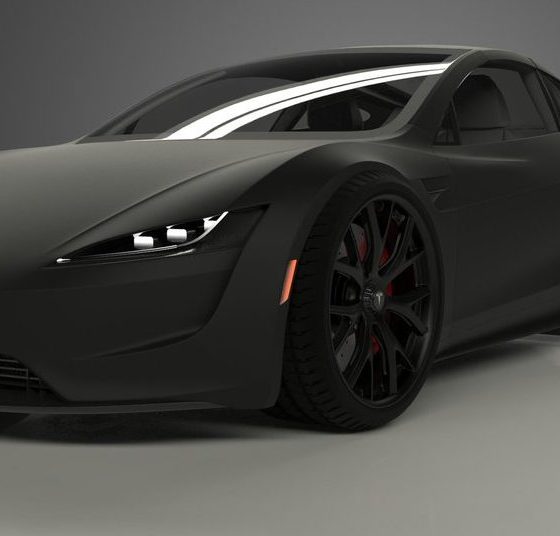Tesla’s next-generation Roadster is designed to be the halo car that outperforms the world’s top supercars in speed, power, and range while shattering world records in the making. But beyond its promised vertigo-inducing performance specifications, the vehicle’s looks competes with the best exotics with its low profile, wide stance, and sleek, aerodynamic lines.
The Silicon Valley electric carmaker appears to have one working prototype of the next-generation Roadster that’s painted in a rich, blazing red. It’s not quite the signature red paint job featured in Elon Musk’s personal Tesla Roadster that was sent on a journey to Mars, but the paint scheme of the prototype is unmistakable and eye-catching. Tesla also appears to have two to-scale models of the next-gen Roadster as well — a midnight silver-esque one featured during the unveiling last November and a white multicoat Roadster that was unveiled in the 2018 Annual Shareholder Meeting.
Considering the next-gen Roadster’s design, there’s arguably not a single color that wouldn’t be jaw-dropping on the all-electric supercar. Graphic designer Miguel Castro exhibited some creativity after the vehicle’s unveiling by envisioning how the Roadster would look in several colors, including “Electric Blue”.
Teslarati‘s very own Reese Wilson also reimagined the 2020 Roadster in a menacing matte black. But matte-colored Teslas won’t be making their way to the factory paint shop anytime soon.

YouTuber and renown tech reviewer Marques Brownlee, and devout fan of matte black everything, digs deeper to find out why Tesla might be sticking to the more traditional glossy paint. In his recent tour of Tesla’s Fremont factory with CEO Elon Musk, Marques asked Musk if Tesla would ever offer a matte black option for its vehicles, particularly since the company did showcase a matte Model 3 prototype when the electric sedan was initially unveiled. Elon Musk’s response was encouraging, at least for the future.
“I actually like the aesthetics of matte. It’s really tricky to repair matte. With gloss, you can polish it out. With matte, if you get like a little ding, it’s really hard to then rematch so it looks like an even matte. We’d like to do matte in the future, but right now, for example, the paint shop is really operating at full tilt, so adding any complexity to the paint shop would not be wise right now, but I think it will be a cool thing to do in the future,” Musk said.
One of the areas that Tesla has struggled in with regards to the Model 3 production ramp was the Fremont factory’s paint shop. In the Q2 2018 earnings call, Musk noted that Tesla is “figuring out how to make the paint shop a lot simpler and general assembly a lot simpler” as the company starts producing the Model 3 in even higher volumes. Tesla’s appears to have made progress with its paint shop improvements since then, as evidenced by the company uploading a rather lighthearted video of a cow udder-like robot used for painting the Model 3.
There is a pretty good chance that Tesla would not be offering matte black as an option for the next-gen Tesla Roadster. Nevertheless, some owners of the all-electric supercar who are fond of the color would likely use wraps as a way to make their vehicles more unique. One of these is Unplugged Performance’s Burnt Orange wrap for the Tesla Model S, which is pretty eye-catching in its own right.
The next-gen Roadster would most likely shatter a lot of competition when it starts rolling out to customers in 2020, especially since the vehicle’s insane specs announced by Musk during its unveiling is true only for the supercar’s base model. Musk has since mentioned another trim for the next-gen Roadster, and that would be even crazier in terms of raw power and speed. That trim is the SpaceX option, a variant of the Roadster that would literally feature rocket tech from SpaceX, Musk’s private space venture. To boost the vehicle’s performance, Musk plans on using Composite Overwrapped Pressure Vessels (COPV), which are used in SpaceX’s first-stage rocket boosters during re-entry and landing.

News
Tesla China delivery centers look packed as 2025 comes to a close
Needless to say, it appears that Tesla China seems intent on ending 2025 on a strong note.

Tesla’s delivery centers in China seem to be absolutely packed as the final days of 2025 wind down, with photos on social media showing delivery locations being filled wall-to-wall with vehicles waiting for their new owners.
Needless to say, it appears that Tesla China seems intent on ending 2025 on a strong note.
Full delivery center hints at year-end demand surge
A recent image from a Chinese delivery center posted by industry watcher @Tslachan on X revealed rows upon rows of freshly prepared Model Y and Model 3 units, some of which were adorned with red bows and teddy bears. Some customers also seem to be looking over their vehicles with Tesla delivery staff.
The images hint at a strong year-end push to clear inventory and deliver as many vehicles as possible. Interestingly enough, several Model Y L vehicles could be seen in the photos, hinting at the demand for the extended wheelbase-six seat variant of the best-selling all-electric crossover.
Strong demand in China
Consumer demand for the Model Y and Model 3 in China seems to be quite notable. This could be inferred from the estimated delivery dates for the Model 3 and Model Y, which have been extended to February 2026 for several variants. Apart from this, the Model Y and Model 3 also continue to rank well in China’s premium EV segment.
From January to November alone, the Model Y took China’s number one spot in the RMB 200,000-RMB 300,000 segment for electric vehicles, selling 359,463 units. The Model 3 sedan took third place, selling 172,392. This is quite impressive considering that both the Model Y and Model 3 are still priced at a premium compared to some of their rivals, such as the Xiaomi SU7 and YU7.
With delivery centers in December being quite busy, it does seem like Tesla China will end the year on a strong note once more.
News
Tesla Giga Berlin draws “red line” over IG Metall union’s 35-hour week demands
Factory manager André Thierig has drawn a “red line” against reducing Giga Berlin’s workweek to 35 hours, while highlighting that Tesla has actually increased its workers’ salaries more substantially than other carmakers in the country.

Tesla Giga Berlin has found itself in a new labor dispute in Germany, where union IG Metall is pushing for adoption of a collective agreement to boost wages and implement changes, such as a 35-hour workweek.
In a comment, Giga Berlin manager André Thierig drew a “red line” against reducing Giga Berlin’s workweek to 35 hours, while highlighting that Tesla has actually increased its workers’ salaries more substantially than other carmakers in the country.
Tesla factory manager’s “red line”
Tesla Germany is expected to hold a works council election in 2026, which André Thierig considers very important. As per the Giga Berlin plant manager, Giga Berlin’s plant expansion plans might be put on hold if the election favors the union. He also spoke against some of the changes that IG Metall is seeking to implement in the factory, like a 35-hour week, as noted in an rbb24 report.
“The discussion about a 35-hour week is a red line for me. We will not cross it,” Theirig said.
“(The election) will determine whether we can continue our successful path in the future in an independent, flexible, and unbureaucratic manner. Personally, I cannot imagine that the decision-makers in the USA will continue to push ahead with the factory expansion if the election results favor IG Metall.”
Giga Berlin’s wage increase
IG Metall district manager Jan Otto told the German news agency DPA that without a collective agreement, Tesla’s wages remain significantly below levels at other German car factories. He noted the company excuses this by referencing its lowest pay grade, but added: “The two lowest pay grades are not even used in car factories.”
In response, Tesla noted that it has raised the wages of Gigafactory Berlin’s workers more than their German competitors. Thierig noted that with a collective agreement, Giga Berlin’s workers would have seen a 2% wage increase this year. But thanks to Tesla not being unionized, Gigafactory Berlin workers were able to receive a 4% increase, as noted in a CarUp report.
“There was a wage increase of 2% this year in the current collective agreement. Because we are in a different economic situation than the industry as a whole, we were able to double the wages – by 4%. Since production started, this corresponds to a wage increase of more than 25% in less than four years,” Thierig stated.
News
Tesla is seeing a lot of momentum from young Koreans in their 20s-30s: report
From January to November, young buyers purchased over 21,000 Teslas, putting it far ahead of fellow imported rivals like BMW and Mercedes-Benz.

Tesla has captured the hearts of South Korea’s 20s-30s demographic, emerging as the group’s top-selling imported car brand in 2025. From January to November, young buyers purchased over 21,000 Teslas, putting it far ahead of fellow imported rivals like BMW and Mercedes-Benz.
Industry experts cited by The Economist attributed this “Tesla frenzy” to fandom culture, where buyers prioritize the brand over traditional car attributes, similar to snapping up the latest iPhone.
Model Y dominates among young buyers
Data from the Korea Imported Automobile Association showed that Tesla sold 21,757 vehicles to the 20s-30s demographic through November, compared to BMW’s 13,666 and Mercedes-Benz’s 6,983. The Model Y led the list overwhelmingly, with variants like the standard and Long Range models topping purchases for both young men and women.
Young men bought around 16,000 Teslas, mostly Model Y (over 15,000 units), followed by Model 3. Young women followed a similar pattern, favoring Model Y (3,888 units) and Model 3 (1,083 units). The Cybertruck saw minimal sales in this group.
The Model Y’s appeal lies in its family-friendly SUV design, 400-500 km range, quick acceleration, and spacious cargo, which is ideal for commuting and leisure. The Model 3, on the other hand, serves as an accessible entry point with lower pricing, which is valuable considering the country’s EV subsidies.
The Tesla boom
Experts described Tesla’s popularity as “fandom culture,” where young buyers embrace the brand despite criticisms from skeptics. Professor Lee Ho-geun called Tesla a “typical early adopter brand,” comparing purchases to iPhones.
Professor Kim Pil-soo noted that young people view Tesla more as a gadget than a car, and they are likely drawn by marketing, subsidies, and perceived value. They also tend to overlook news of numerous recalls, which are mostly over-the-air software updates, and controversies tied to the company.
Tesla’s position as Korea’s top import for 2025 seems secured. As noted by the publication, Tesla’s December sales figures have not been reported yet, but market analysts have suggested that Tesla has all but secured the top spot among the country’s imported cars this year.










